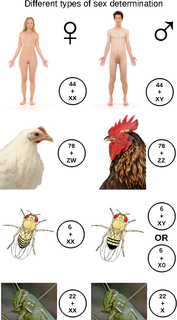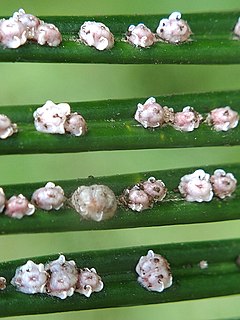Related Research Articles

A gamete is a haploid cell that fuses with another haploid cell during fertilization in organisms that reproduce sexually. Gametes are an organism's reproductive cells, also referred to as sex cells. In species that produce two morphologically distinct types of gametes, and in which each individual produces only one type, a female is any individual that produces the larger type of gamete—called an ovum— and a male produces the smaller type—called a sperm. Sperm cells or spermatozoa are small and motile due to the flagellum, a tail-shaped structure that allows the cell to propel and move. In contrast, each egg cell or ovum is relatively large and non-motile. In short a gamete is an egg cell or a sperm. In animals, ova mature in the ovaries of females and sperm develop in the testes of males. During fertilization, a spermatozoon and ovum unite to form a new diploid organism. Gametes carry half the genetic information of an individual, one ploidy of each type, and are created through meiosis, in which a germ cell undergoes two fissions, resulting in the production of four gametes. In biology, the type of gamete an organism produces determines the classification of its sex.

Hymenoptera is a large order of insects, comprising the sawflies, wasps, bees, and ants. Over 150,000 living species of Hymenoptera have been described, in addition to over 2,000 extinct ones. Many of the species are parasitic. Females typically have a special ovipositor for inserting eggs into hosts or places that are otherwise inaccessible. This ovipositor is often modified into a stinger. The young develop through holometabolism —that is, they have a wormlike larval stage and an inactive pupal stage before they mature.
Genomic imprinting is an epigenetic phenomenon that causes genes to be expressed or not, depending on whether they are inherited from the mother or the father. Genes can also be partially imprinted. Partial imprinting occurs when alleles from both parents are differently expressed rather than complete expression and complete suppression of one parent's allele. Forms of genomic imprinting have been demonstrated in fungi, plants and animals. In 2014, there were about 150 imprinted genes known in mice and about half that in humans. As of 2019, 260 imprinted genes have been reported in mice and 228 in humans.

Meiosis is a special type of cell division of germ cells in sexually-reproducing organisms that produces the gametes, such as sperm or egg cells. It involves two rounds of division that ultimately result in four cells with only one copy of each chromosome (haploid). Additionally, prior to the division, genetic material from the paternal and maternal copies of each chromosome is crossed over, creating new combinations of code on each chromosome. Later on, during fertilisation, the haploid cells produced by meiosis from a male and female will fuse to create a cell with two copies of each chromosome again, the zygote.

Ploidy is the number of complete sets of chromosomes in a cell, and hence the number of possible alleles for autosomal and pseudoautosomal genes. Sets of chromosomes refer to the number of maternal and paternal chromosome copies, respectively, in each homologous chromosome pair, which chromosomes naturally exist as. Somatic cells, tissues, and individual organisms can be described according to the number of sets of chromosomes present : monoploid, diploid, triploid, tetraploid, pentaploid, hexaploid, heptaploid or septaploid, etc. The generic term polyploid is often used to describe cells with three or more chromosome sets.

Sex is the trait that determines whether a sexually reproducing animal or plant produces male gametes or female ones. Male plants and animals produce smaller gametes while females produce larger ones. Organisms that produce both types of gametes are called hermaphrodites. During sexual reproduction, male and female gametes fuse to form zygotes, which develop into offspring that inherit traits from each parent.

A zygote is a eukaryotic cell formed by a fertilization event between two gametes. The zygote's genome is a combination of the DNA in each gamete, and contains all of the genetic information of a new individual organism.

A sex-determination system is a biological system that determines the development of sexual characteristics in an organism. Most organisms that create their offspring using sexual reproduction have two sexes.
A somatic cell, or vegetal cell, is any biological cell forming the body of a multicellular organism other than a gamete, germ cell, gametocyte or undifferentiated stem cell. Such cells compose the body of an organism and divide through the process of binary fission and mitotic division.

In biology, a biological life cycle is a series of changes in form that an organism undergoes, returning to the starting state. "The concept is closely related to those of the life history, development and ontogeny, but differs from them in stressing renewal." Transitions of form may involve growth, asexual reproduction, or sexual reproduction.

Scale insects are small insects of the order Hemiptera, suborder Sternorrhyncha. Of dramatically variable appearance and extreme sexual dimorphism, they comprise the infraorder Coccomorpha which is considered a more convenient grouping than the superfamily Coccoidea due to taxonomic uncertainties. Adult females typically have soft bodies and no limbs, and are concealed underneath domed scales, extruding quantities of wax for protection. Some species are hermaphroditic, with a combined ovotestis instead of separate ovaries and testes. Males, in the species where they occur, have legs and sometimes wings, and resemble small flies. Scale insects are herbivores, piercing plant tissues with their mouthparts and remaining in one place, feeding on sap. The excess fluid they imbibe is secreted as honeydew on which sooty mold tends to grow. The insects often have a mutualistic relationship with ants, which feed on the honeydew and protect them from predators. There are about 8,000 described species.
Intragenomic conflict refers to the evolutionary phenomenon where genes have phenotypic effects that promote their own transmission in detriment of the transmission of other genes that reside in the same genome. The selfish gene theory postulates that natural selection will increase the frequency of those genes whose phenotypic effects cause their transmission to new organisms, and most genes achieve this by cooperating with other genes in the same genome to build an organism capable of reproducing and/or helping kin to reproduce. The assumption of the prevalence of intragenomic cooperation underlies the organism-centered concept of inclusive fitness. However, conflict among genes in the same genome may arise both in events related to reproduction and altruism.
Meiotic drive is a type of intragenomic conflict, whereby one or more loci within a genome will effect a manipulation of the meiotic process in such a way as to favor the transmission of one or more alleles over another, regardless of its phenotypic expression. More simply, meiotic drive is when one copy of a gene is passed on to offspring more than the expected 50% of the time. According to Buckler et al., "Meiotic drive is the subversion of meiosis so that particular genes are preferentially transmitted to the progeny. Meiotic drive generally causes the preferential segregation of small regions of the genome".

Arrhenotoky, also known as arrhenotokous parthenogenesis, is a form of parthenogenesis in which unfertilized eggs develop into males. In most cases, parthenogenesis produces exclusively female offspring, hence the distinction.

Haplodiploidy is a sex-determination system in which males develop from unfertilized eggs and are haploid, and females develop from fertilized eggs and are diploid. Haplodiploidy is sometimes called arrhenotoky.

Parthenogenesis is a natural form of asexual reproduction in which growth and development of embryos occur in a gamete without combining with another gamete. In animals, parthenogenesis means development of an embryo from an unfertilized egg cell. In plants, parthenogenesis is a component process of apomixis. In algae, parthenogenesis can mean the development of an embryo from either an individual sperm or an individual egg.

Sexual reproduction is a type of reproduction that involves a complex life cycle in which a gamete with a single set of chromosomes combines with another gamete to produce a zygote that develops into an organism composed of cells with two sets of chromosomes (diploid). This is typical in animals, though the number of chromosome sets and how that number changes in sexual reproduction varies, especially among plants, fungi, and other eukaryotes.

Eusociality evolved repeatedly in different orders of animals, particularly the Hymenoptera. This 'true sociality' in animals, in which sterile individuals work to further the reproductive success of others, is found in termites, ambrosia beetles, gall-dwelling aphids, thrips, marine sponge-dwelling shrimp, naked mole-rats, and the insect order Hymenoptera. The fact that eusociality has evolved so often in the Hymenoptera, but remains rare throughout the rest of the animal kingdom, has made its evolution a topic of debate among evolutionary biologists. Eusocial organisms at first appear to behave in stark contrast with simple interpretations of Darwinian evolution: passing on one's genes to the next generation, or fitness, is a central idea in evolutionary biology.
Gynogenesis, a form of parthenogenesis, is a system of asexual reproduction that requires the presence of sperm without the actual contribution of its DNA for completion. The paternal DNA dissolves or is destroyed before it can fuse with the egg. The egg cell of the organism is able to develop, unfertilized, into an adult using only maternal genetic material. Gynogenesis is often termed “sperm parasitism” in reference to the somewhat pointless role of male gametes. Gynogenetic species, "gynogens" for short, are unisexual, meaning they must mate with males from a closely related bisexual species that normally reproduces sexually. It’s a disadvantageous mating system for males, as they are unable to pass on their DNA. The question as to why this reproductive mode exists, given that it appears to combine the disadvantages of both asexual and sexual reproduction, remains unsolved in the field of evolutionary biology.
Androgenesis occurs when a zygote is produced with only paternal nuclear genes. During standard sexual reproduction, one female and one male parent each produce haploid gametes(such as a sperm or egg cell, each containing only a single set of chromosomes), which recombine to create offspring with genetic material from both parents. However, in androgenesis, there is no recombination of maternal and paternal chromosomes, and only the paternal chromosomes are passed down to the offspring. The offspring produced in androgenesis will still have maternally inherited mitochondria, as is the case with most sexually reproducing species.
References
- 1 2 Sabelis, M. W.; Nagelkerke, C. J. (1988). "Evolution of pseudo-arrhenotoky" (PDF). Experimental & Applied Acarology. 4 (3): 301–318. doi:10.1007/BF01196192.
- 1 2 Borsa, P.; Kjellberg, F. (1996). "Experimental evidence for pseudo-arrhenotoky in Hypothenemus hampei (Coleoptera: Scolytidae)". Heredity. 76 (2): 130–135. doi: 10.1038/hdy.1996.20 .
- ↑ Bongiorni, S.; Mazzuoli, M.; Masci, S.; Prantera, G. (2001). "Facultative heterochromatization in parahaploid male mealybugs: Involvement of a heterochromatin-associated protein". Development. 128 (19): 3809–3817. PMID 11585806.
- ↑ Andersen, J. C.; Wu, J; Gruwell, M. E.; Gwiazdowski, R; Santana, S. E.; Feliciano, N. M.; Morse, G. E.; Normark, B. B. (2010). "A phylogenetic analysis of armored scale insects (Hemiptera: Diaspididae), based upon nuclear, mitochondrial, and endosymbiont gene sequences". Molecular Phylogenetics and Evolution. 57 (3): 992–1003. doi:10.1016/j.ympev.2010.05.002. PMID 20460159.
- ↑ Ross, L.; Pen, I.; Shuker, D. M. (2010). "Genomic conflict in scale insects: The causes and consequences of bizarre genetic systems". Biological Reviews. 85 (4): 807–28. doi:10.1111/j.1469-185X.2010.00127.x. PMID 20233171.
- ↑ Haig, D. (1993). "The evolution of unusual chromosomal systems in coccoids: Extraordinary sex ratios revisited". Journal of Evolutionary Biology (Free full text). 6: 69–77. doi: 10.1046/j.1420-9101.1993.6010069.x .
- 1 2 Nagelkerke, C. J.; Sabelis, M. W. (1998). "Precise control of sex allocation in pseudo-arrhenotokous phytoseiid mites". Journal of Evolutionary Biology. 11 (6): 649–684. doi: 10.1046/j.1420-9101.1998.11060649.x .
- ↑ Normark, B. B. (2003). "The evolution of alternative genetic systems in insects". Annual Review of Entomology. 48: 397–423. doi:10.1146/annurev.ento.48.091801.112703. PMID 12221039.
- 1 2 Cruickshank, R. H.; Thomas, R. H. (1999). "Evolution of Haplodiploidy in Dermanyssine Mites (Acari: Mesostigmata)". Evolution. 53 (6): 1796–1803. doi:10.2307/2640441. JSTOR 2640441.